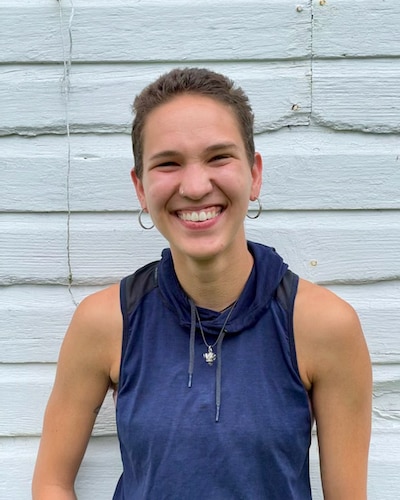“Are you a boy or a girl?” My fifth grade student asked me earnestly at the end of the first day of the after-school game design class I teach.
I chuckled, caught off guard by the question. “Neither of those words really fits me,” I told her. “I’m non-binary, which means I don’t identify as a boy or a girl.”
“Is that like a tomboy?” she asked.
“Sort of like that. But sometimes tomboys identify as girls,” I explained. “I don’t fit in that category.”

Another student overheard our conversation and announced to the room: “Whatever you are, tomboy, tomgirl, gay, straight, you are welcome here!”
I smiled, hopeful for the more inclusive world these 10-year-olds can build. Feeling inspired by their example, I asked myself: What if all of my students could feel as accepted in my classroom as I did in this conversation?
Though I identify as non-binary, I had not made a habit of sharing this information in my classrooms. I was not out at the school where I taught previously — after being mocked by former co-workers when I mentioned my discomfort with the gendered honorific “Ms.,” I felt exhausted by the prospect of being vocal about my identity at work. I still sought to be an advocate for queer students: I constantly corrected co-workers who misgendered trans and non-binary students. I confronted teachers who joked about queerness as a mental illness. I pushed for reading materials that included LGBTQ representation (unfortunately, to little avail). Ultimately, the fatigue of pressing for inclusivity in an unyielding environment led me to look for work elsewhere.
Though I identify as non-binary, I had not made a habit of sharing this information in my classrooms.
Now, I teach at arts and theater nonprofits that are more supportive of LGBTQ staff and students. Even in these more accepting spaces, I was unsure at first how to navigate conversations about gender identity in my classes. While I wanted to invite students to share their chosen names and pronouns, I was hesitant about explaining my gender during an introductory class. I worried about how students might react.
But the impromptu conversation about my non-binary identity made me realize that kids are more open than I gave them credit for. More importantly, I felt responsible for fostering an environment where all my students would feel accepted and affirmed for their identities.
So I incorporated a conversation about chosen names and pronouns into the first day of my next session of classes. I started by asking if anyone in the class had a favorite nickname. A student volunteered, “My full name is Alejandro, but no one calls me that. I’m really Ali.” When I asked why he liked this name, he said, “I don’t know. … I guess it just feels more like me.”
“I totally get that,” I replied. “It’s the same way I feel about my nickname ‘Meb.’ I like when students call me ‘Meb’ rather than ‘Ms.’ because it feels more like me.” I told students that it’s important to me to use language to describe them that feels right. I shared my hope that this can help everyone feel like their best self in our classroom.
I then took a moment to ask the class if anyone could explain what a “pronoun” is. I knew the term “pronoun” might be new for some students, and I wanted to make sure everyone was on the same page before asking students to share.
“It’s how you refer to someone, like ‘he’ or ‘she,’” a student offered. I affirmed this definition and shared that I use the pronouns “they” and “them.”
“If you want to tell your friends how fun our class is,” I offered, “this is how you would use my pronouns: ‘Meb is awesome! They are the coolest teacher ever.’ Or if you want to complain about me, you could say: ‘Meb is annoying. Their jokes are ridiculous!’”
I told the class that I understood these pronouns might be new to them and that it’s all right if they use “she” and “her” by accident, but I would correct them nicely. I invited the students to correct me and our other classmates if we pronounced their name wrong or used an incorrect pronoun.
The students quickly grasped the concepts of pronouns and chosen names and seemed eager to share. In particular, students delighted in the opportunity to select a nickname, sometimes inventing a new one to use specifically for our class. This reaction revealed the deeper value of the conversation: It created an opportunity for students to exercise agency and even creativity in how they are seen and referred to in the classroom community. By sharing my full self as a teacher, I also encouraged students to express themselves fully.
Unfortunately, many educators still view sharing chosen names and pronouns as a radical or unnecessary practice. I have often heard the warped rhetoric of “Don’t Ask, Don’t Tell” translated in a school setting as: “I accept everyone, but it’s not appropriate to talk about sexuality with students.” This attitude implies that sexualities and genders outside of hetero- and cis-norms are shameful and should be hidden.
Moreover, it erases the ways that queerness shapes self-image and connects people to a community and history. When educators avoid conversations about gender and sexuality, they reinforce a culture where young people’s identities are decided by the adults around them, and straying from expectations is deterred. Inviting students to share language that affirms their identities is an important first step towards changing this culture.
This is not the only action needed to foster student empowerment — educators must work every day to understand their students’ perspectives, celebrate their varied identities and cultures, and build communities grounded in acceptance, compassion, and mutual respect. Students learn better when they feel free to be their authentic selves: They ask more questions, connect their personal experiences to their learning, and engage more fully in the classroom community. Discussing names and pronouns offers an important foundation for building this type of liberated classroom. It establishes a culture of agency and independent thinking and shows students from day one that their voices and identities matter.
Marielle Burt is a Providence-based educator who uses design thinking as the basis for game design and theater courses. They currently teach classes at The Manton Avenue Project, City Arts, and The Wilbury Theater.



